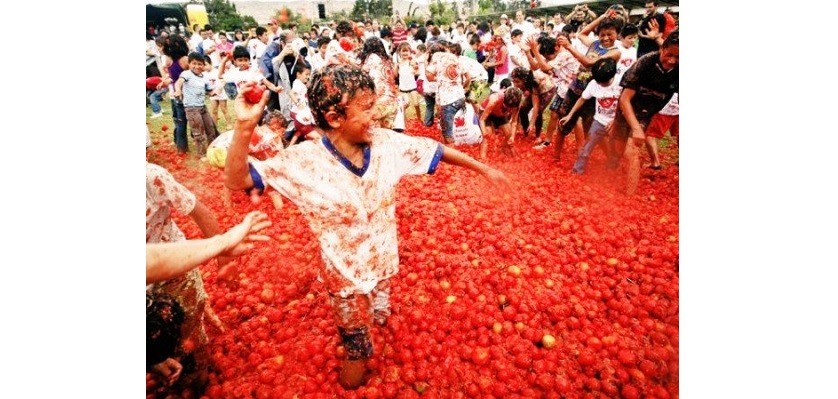La Tomatina

Welcome to English Waves! I’m Sarah Heath with traditions around the globe.
This summer will mark the 74th anniversary of one of Spain's more quirky festivals – la tomatina. In essence a giant food fight, it is hosted annually by the small town of Buñol located 40km west of Valencia on the last Wednesday in August. The name is a bit of a giveaway – yes, it involves tomatoes! – but the origins to this tomato-throwing tradition are slightly less clear.
The very first tomato was thrown back in 1945 but there are various versions on how this came about: one legend has it that during a parade, a frustrated participant got into a fight with children whereupon they started throwing tomatoes at each other; another states that it was a protest against the local government while some say it was simply a tomato truck which had an unfortunate accident. Regardless of its origins, the local people thought it was far too much fun not to repeat and decided to adopt it as a new tradition to be held each year.
Buñol has a population of around 9,600 people but this swells hugely on the day of the festival when 20,000 tomato-lovers descend on the town for some food-fighting entertainment. Locals pin up plastic sheeting to protect the front of their houses. These residents have a height advantage over the crowds on the ground and stock up on tomatoes to fire down from their roofs during the fight.
Just prior to the arrival of the tomatoes, another bizarre tradition takes place in the town square which involves climbing a greasy pole, the equivalent of two-storeys in height, to reach a ham – or jamón in the local lingo. Once this has been accomplished a shot is fired at precisely 11 o'clock and six tomato-laden lorries roll slowly through the main street to provide the crowds with their eagerly-awaited ammunition. A small number of people pay up to €750 for the privilege of sitting on top of the lorries to start pelting people with tomatoes before the trucks tip out the rest of their squishy load and the mayhem really starts!
Around 150,000 kilos of ripe tomatoes are hurled in what quickly looks like a bloodbath – except of the tomato-ey kind. Participants become indistinguishable as everyone turns red, sometimes ankle deep in the squashed fruit. Scenes of joyous hilarity ensue as tomato missiles make contact with their intended targets. There is little escape in the narrow streets which are tightly packed with people as the ground becomes a river of tomato sauce.There are few rules save some safety guidelines and the hour-long battle must end when a second shot is fired. It has become part of unofficial sartorial etiquette to wear a white t-shirt so that before-and-after scenes are more pronounced. Many people wear goggles, some even going as far as wearing snorkelling masks!
The festival hasn't always gone to plan in its lifetime: it was banned for several years in the 1950s but such was the strength of public opinion against the ban, a mock tomato burial was staged in which a giant tomato was put inside a coffin that was then paraded through the streets to the sounds of a funeral march. As a happy consequence, the festival was re-instated and its popularity today has meant that for the last three years, it is necessary to reserve in advance.
Once the battle finishes, the clean-up operation starts immediately as fire engines, with the help of hose-brandishing locals, spray down the streets and the party-goers with water. One slightly odd side-effect of the festival is that once everything has been hosed off, walls and pavements look even cleaner than before the event: the acidity of the tomato juice acts as a natural cleaning agent!
Unsurprisingly, the festivities include a huge party with music and plenty of sangria. All a part of the festival's aim to promote happiness and entertainment.
Listen in to English Waves for the next program on world traditions.








COMMENTS